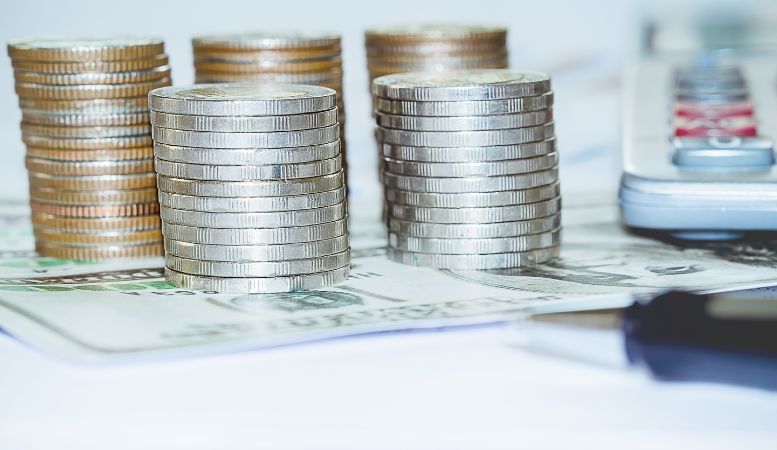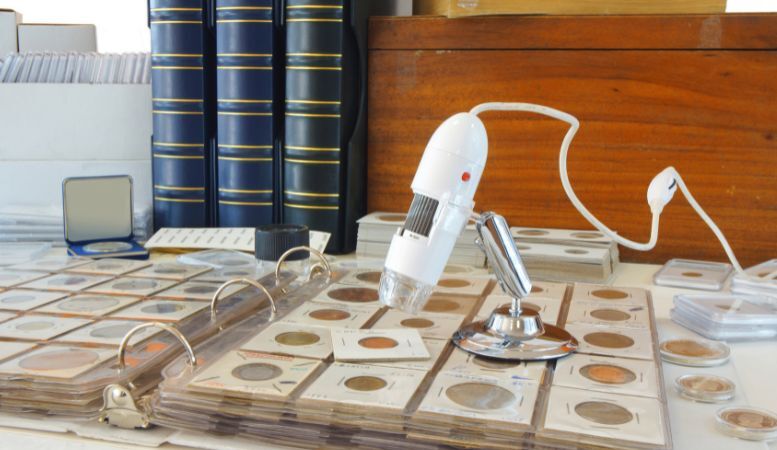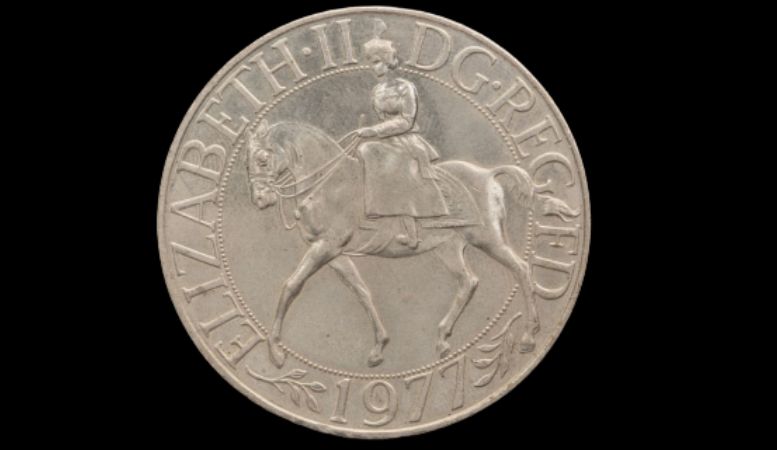Table of Contents
Jubilee coins are some of the most popular, but since several factors affect their value, even the most experienced numismatists need help establishing their value. So, are 1977 Jubilee coins worth anything?
In this guide by Oxford Gold Group, discover everything you need to know about these commemorative coins, including how to properly identify a 1977 Silver Jubilee coin, factors affecting their value, and how to build numismatic value through your commemorative coin collection.
What Are Jubilee Coins: An Overview
Jubilee coins are a type of British commemorative coinage (also known as a crown) that celebrates a monarch’s coronation anniversary. One side of the coin depicts the silhouette of the monarch, and the other an additional design along with the year of the anniversary and minting of the coin.
The 1977 Silver Jubilee coins commemorate the 25th anniversary of Queen Elizabeth II’s coronation. Queen Elizabeth was crowned in 1952, so in 1977 when she celebrated her Silver Jubilee of 25 years on the throne, the Royal Mint produced two versions of these silver commemorative coins.
If you own a 1997 Silver Jubilee coin, you have one of these two versions:
- Cupronickel Version: The Royal Mint produced over 37 million Jubilee coins from a nickel-copper alloy. The coin garnered considerable popularity, and millions of coins still exist as souvenirs and commemorative keepsakes.
- Silver Version: The Royal Mint minted these proof coins before the main production of the cupronickel version as a means of obtaining design approval from the finance minister. These coins contain higher concentrations of sterling silver, and the Mint only produced 377,000, making them significantly rarer than their cupronickel counterparts. Officially, the silver version of the coin contains .841 troy ounces of .925 sterling silver.
Both versions of the 1977 Silver Jubilee coin are worth something, but the silver version has a much higher value.
Value and Pricing: What Is a 1977 Jubilee Coin Worth?

The cupronickel version of the 1977 Silver Jubilee crown sells for around £1.42 on average. The silver proof version, both because of its increased rarity and the amount of silver it contains, generally sells for between £30 and £60, depending on its condition.
Like any piece in your collection, the coin value depends on the following factors.
Face Value
While mostly commemorative, the original Silver Jubilee crown held a face value of 25 pence and qualified as legal tender. Despite its innate value, most people chose not to spend it but instead kept the coin as part of their coin collection for the sentimental value it held around Queen Elizabeth II’s reign. In fact, many businesses refused to accept them, resulting in a large quantity of coins still existing.
Condition Value
Condition is one of the most important and consistent determiners of a coin’s value. Experts grade a coin’s condition on a 70-point scale ranging from P-1 (Poor) to MS-70 (Mint State Perfect). A rating of P-1 means the coin is barely identifiable, and the coin’s perfect condition contains no flaws, even at the microscopic level.
While you could sell a Silver Jubilee crown in perfect mint condition at the highest end of the price spectrum, as the coin becomes damaged or enters circulation, the value quickly drops. Are you unsure of what condition your coin is in? Oxford Gold Group can connect you with experts to determine the condition of your coins or gold products.
Material Value
The coin’s precious metals also heavily affect its value. While the cupronickel coin contains only common metals and is not likely to significantly increase in value, the value of the sterling silver version of the coin increases with the price of silver and thus should continue to increase in value, albeit slowly.
Rarity

The rarity of a coin directly affects its value. Because the government minted so many 1977 Silver Jubilee coins and most never entered circulation, a large number of them still exist. While the value could increase as people lose or damage more coins, experts don’t agree on whether this particular coin will increase in rarity.
Casing Value
As commemorative and collectible pieces, many Silver Jubilee crowns came in a special case or box. While storing it in these cases reduces potential damage to the coin (thus helping maintain its condition), it also increases the coin’s value as a collectible item. Collectors appreciate not only the protection the case provides but also the look and sentimentality that come from having both the coin and its case.
The most common case is a small blue ring box with a picture of the British crown and the date “6 February 1977” printed on the top. Other authentic cases include a small transparent plastic sleeve with the dates 1952 and 1977 printed or a clear hard-cased plastic box containing the same lettering. Some cases also have red, green, or black backgrounds.
Are 1977 Silver Jubilee coins worth anything without the case? Yes, but not as much as they’re worth with the original commemorative box. If you don’t have the case, consider purchasing a generic plastic case or sleeve that keeps the coin safe while still displaying its beauty and condition.
Value From Anomalies
Although rare, mistakes during the minting process can significantly increase the value of the affected coin. For example, an improperly minted 1977 Silver Jubilee crown came to auction in 2014. The flaw came from an error in the striking process, creating a coin with an off-center design.
While the final selling price was never recorded, experts valued the coin between £100 and £150, up to triple its average price. Other errors that can increase the value of your coin include:
- Chipped planchet: This occurs when the punching machine doesn’t advance far enough during production. These coins look like they have chips or dents around their edges.
- Cracks or cuds: These blob-like areas on the coin’s surface occur when the surface of the coin suffers damage from repeated strikes during the minting process.
- Blank planchet: When the minting process fails to imprint a design on the coin, it results in a blank planchet. While designs that have worn away from circulation make a coin nearly worthless, a blank planchet error can increase the coin’s value.
The Value in Collecting Commemorative Coins

If you’re disappointed in the answer to “Are 1977 Jubilee coins worth anything?” don’t give up on collecting commemorative coins yet. When you collect commemorative coins, you can add significant value to your portfolio.
The coin is still a valuable part of your collection because, like all commemorative coins, it has three defining qualities. What makes commemorative coins so valuable?
Sentimentality
Because technology in 1977 increased access to and awareness of Queen Elizabeth II’s Silver Jubilee, it was one of the most popular events in modern British history, and the celebrations spanned months in England and around the world. British citizens and fans of the monarchy worldwide hold fond memories of the event and thus actively seek out souvenirs that help preserve the memories of that time.
The 1977 Silver Jubilee coin exemplifies what makes these commemorative coins valuable: they appeal to more than just coin collectors. Whether it’s a political event or a celebration of culture, people value these coins as mementos and nostalgic evocations of the past. This means you can find a buyer for a commemorative coin much more easily than other, more esoteric collector coins.
Limited Edition
The Royal Mint produced tens of millions of the 1997 Jubilee coin, but that doesn’t make them common. Many special coins only undergo minting for a single year, making them limited edition collector’s items. While they might not carry significant value, they’re frequently worth more than their legal tender value.
Decreasing Availability
Even with millions of copies minted through trade, improper care, and occasional circulation, the number of commemorative coins slowly dwindles. As fewer coins appear at auctions and conventions, the price slowly increases for the coins as a whole. While not every commemorative coin increases in rarity, it’s worth consulting with an expert to determine whether the coin is worth keeping or selling.
Numismatists remain unsure whether the 1977 Jubilee coin will experience the same decrease in supply, but if it does, you’ll appreciate the fact that you kept it.
1977 Jubilee Coin Design and Features

Are 1977 Jubilee coins worth anything? First, establish whether your collectible coin is truly a Silver Jubilee crown.
Coin Face and Edge Inscription
The front (obverse) side of the coin features a portrait of Queen Elizabeth II in Guards uniform on horseback. The text, “ELIZABETH II DG. REG FD 1977” surrounds the portrait as an edge inscription.
The reverse side, designed by renowned artist Arnold Machin, contains an Ampulla, a small flask in the shape of an eagle, and a small spoon beneath. Decorative heraldic flowers surround the eagle, culminating at the top with the crown of St. Edward. The coin does not contain a visible designation of its worth, like normal currency.
Coin Version
Both the cupronickel coin and the rarer silver proof coin look exactly alike and have only imperceptible differences in weight and size. So how do you tell which version you have?
The cupronickel coin is thicker and measures 3.2 millimeters thick, while the rare silver version is only 2.89 millimeters thick. You can determine which version you have by using a finely detailed metric ruler.
If you’re having trouble verifying which version you own, the partners working with Oxford Gold Group can help you identify your coin. Because we work with experts in precious metals and silver products, we can accurately appraise your collection to determine its investment potential.
Authenticity Verification for 1977 Jubilee Coins
Are you wondering whether you have an authentic 1977 Silver Jubilee coin? Ideally, you have the certificate of authenticity that comes with each coin.
If you don’t have the certificate, you can use the Jubilee coin’s official physical characteristics to determine its authenticity. To verify you have a genuine crown:
- Run your finger around the edge to confirm it contains the ridges indicative of a milled coin.
- An authentic 1977 Silver Jubilee crown weighs 28.28 grams (.997 ounces) and feels much heavier than an average coin.
- The coin measures 3.83 cm (38.61 mm) across, which is significantly bigger than the 20 pence coin (2.14 cm).
If your coin matches all these measurements, congratulations: You likely have an authentic 1977 Silver Jubilee coin!
Contact Oxford Gold Group for Help Building a Valuable Coin Collection
Are 1977 Jubilee coins worth anything? Yes, especially if you have one of the 377,000 silver versions. Still, the 1977 Jubilee coin is just a single coin in your collection.
When you consider a gold IRA or silver IRA with Oxford Gold Group, you’re securing your future regardless of economic uncertainty and market fluctuations. If you want to actualize the benefits of a precious metal IRA, call us at 855-940-6206.








